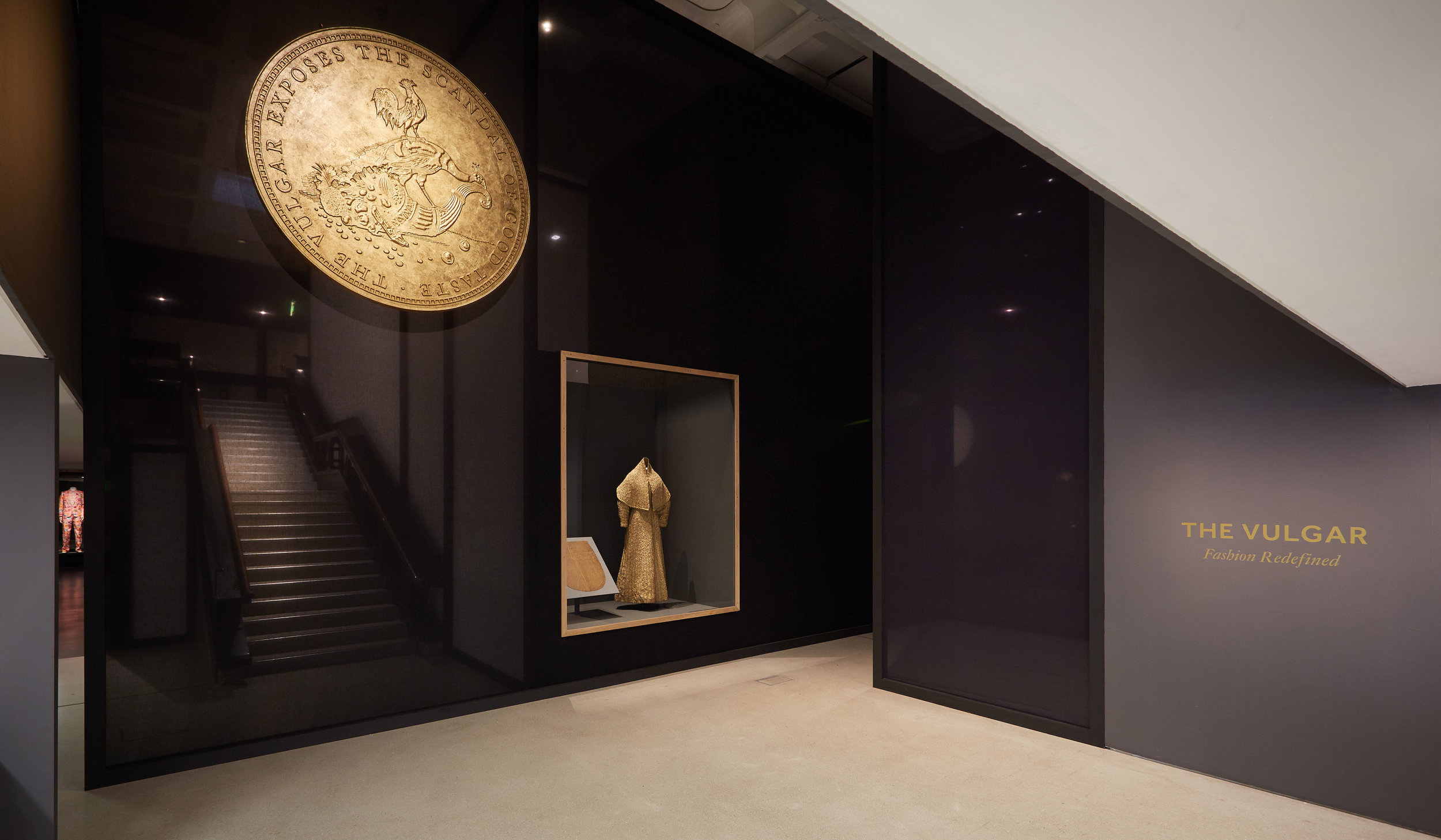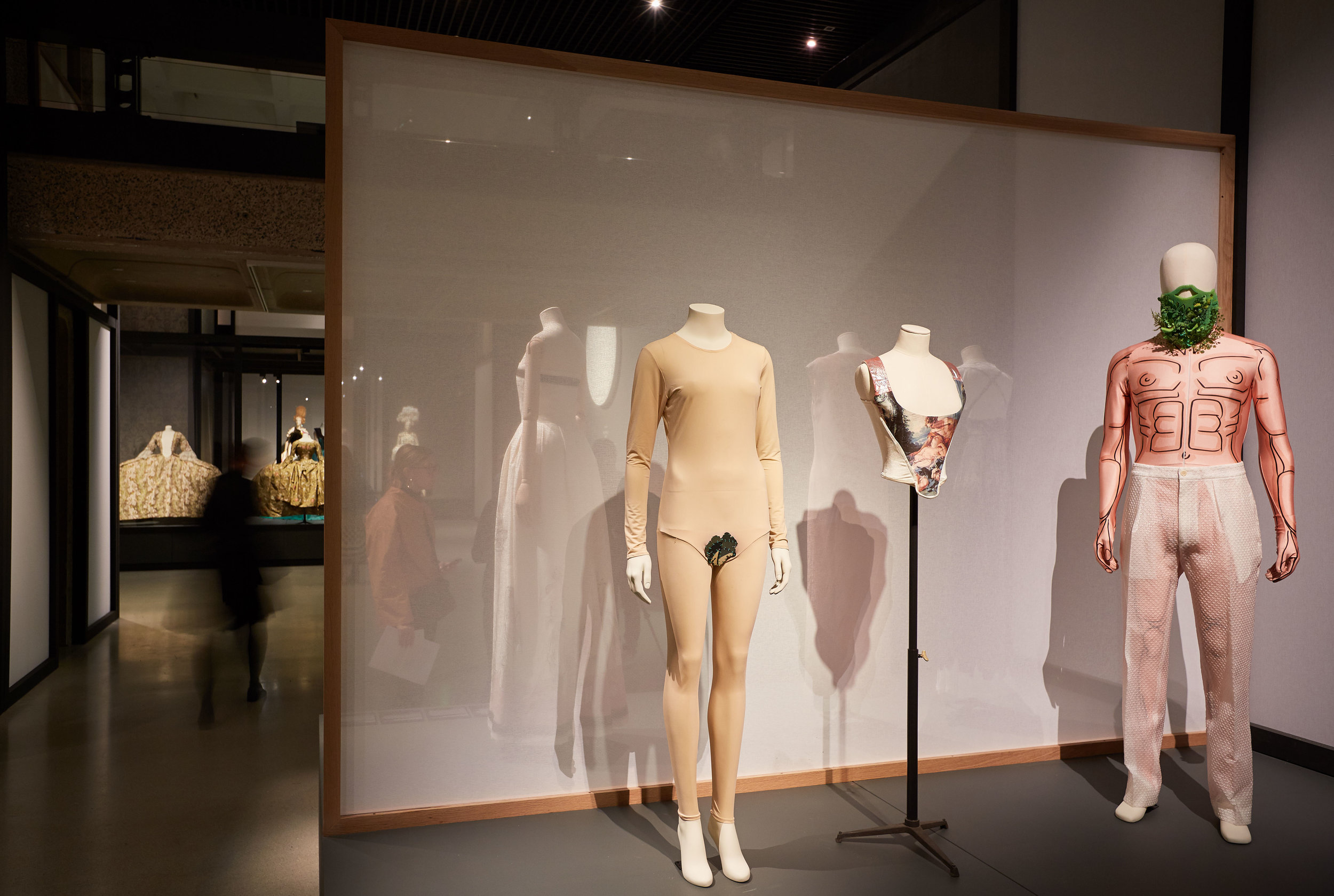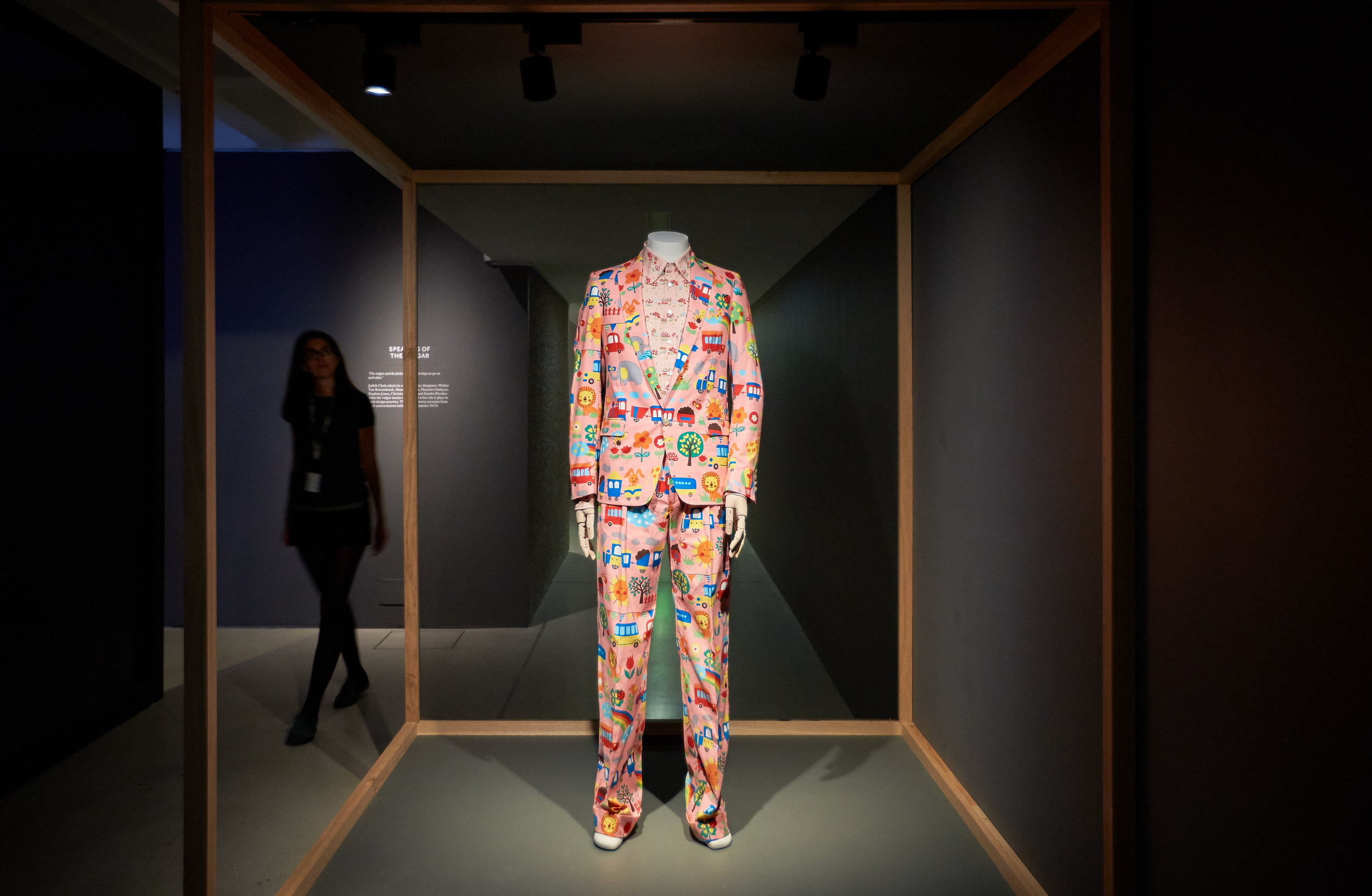The Vulgar: Fashion Redefined
Barbican Art Gallery (London, UK), October 13, 2016-February 5, 2017
““The word ‘vulgar’ is used to police the boundaries of taste. Fashion is where good taste and bad taste mix and match.” ”
A series of definitions greet visitors at the entrance to The Vulgar: Fashion Redefined at London’s Barbican Art Gallery. An eighteenth century definition of vulgar penned by Samuel Johnson accompanies the definitions of vulgar, vulgarism, vulgarity and vulgarly from the Shorter Oxford English Dictionary (1974). The definitions are necessary as the exhibition is concerned with a wider definition of vulgar than the one to which our modern sensibilities may immediately jump. Today, we often associate the word with references to sex or bodily functions. While this definition can be found in The Vulgar, the exhibition as a whole primarily focuses on the notions of what constitutes good and bad taste.
Fashion curator Judith Clark teamed with her husband, psychoanalyst Adam Phillips, for a second time to create The Vulgar (she previously teamed with him for The Concise Dictionary of Dress at the V&A’s Blythe House in 2010). Throughout the exhibition, Philips’ expanded definitions of vulgar signpost the different sections and help the visitor discern how the concept is variously defined. The overarching theme is that “the vulgar exposes the scandal of good taste.” Indeed, class, money, wealth, and taste are at the center of the exhibition as each of Phillips’ definitions builds on the last.
Each section is largely self-contained but nevertheless stays within the parameters of the exhibition’s grand narrative. Throughout the two story space, historical costumes sit alongside more contemporary catwalk ensembles, largely resisting a chronological structure while exploring how “the vulgar” has existed and evolved over the last 500 years. The exhibition starts out slowly, with several different takes on white Grecian-style dresses by the likes of Madame Grès and Chanel. “How are these vulgar?” the visitor might ask herself. But we must go back to the definition of vulgar as being the language of the common people. The seemingly pure white dresses translate classical imagery and ideals (that is, unchanging and timeless) into a form of the vernacular: fashion. In this way, Clark and Phillips introduce how we may be forced to reconceive our notions of vulgarity throughout the show.
The two-level exhibition offers myriad objects that help illustrate just how complex the notion of the vulgar can be. Coexisting happily alongside one another are eighteenth century fans, Maison Martin Margiela for H&M garments, Dutch bonnets made from gold thread, the infamous Gucci pubic hair advertisements, and even an Elizabethan document outlining Tudor sumptuary laws. From Yves Saint Laurent’s Mondrian dress and its subsequent copies to court mantuas from the eighteenth century and Vivienne Westwood’s “Eve” bodysuit, the exhibition shows the shocking and the tasteless – even if today we find nothing wrong with it. The Vulgar explores themes in fashion like copies, consumption, and the relationship between wealth and class, as well as artificiality in appearance and, of course, the concept of vulgarity and its relationship with the body.
A film featuring excerpts from interviews with six contemporary designers helps to drive home the complexities inherent in the theme. Indeed, vulgarity is a matter of opinion. In his interview, milliner Stephen Jones uses Johnny Rotten to explain that something plain and unassuming might have been classified as vulgar by Johnny Rotten, while something he wore would be vulgar to someone more conservative. That’s The Vulgar’s biggest takeaway: vulgarity is subjective and a matter of taste.
Known for her elaborate staging, Judith Clark does not disappoint. Clark actually studied architecture at both an undergraduate and graduate level, but towards the end of her studies, she found herself drawn to dress. This combination has resulted in exhibitions of costume and dress that challenge the temporal and spatial aspects of fashion. Speaking of exhibitions at her Costume Gallery, Alexandra Palmer wrote in Fashion Theory that, “Clark’s combination of modesty and chutzpah, coupled with intelligence and thoughtfulness about fashion and art, was part of her success.” [1] These themes permeate The Vulgar: the exhibition is elegantly staged, though understated with brilliantly lit display cases drawing attention to the garments and ensuring they make the most impact. Meanwhile, Phillips’ definitions, alongside more pointed text about the garments themselves, display critical thought about the relationship between vulgarity, fashion, media and fashion exhibitions themselves.
One of the most striking (and perhaps successful) rooms in terms of spatial display is simply called “Puritan.” Though a small space with only two ensembles and a row of lace collars, it is the lighting that brings this room to life. Again, we may not immediately associate Puritanism with vulgarity, but Clark explains (on the placard) that, “Puritan dress, with its denial of colour and decoration, and its assumed denial of pleasure, forgets the pleasures of denial.” She goes on to write of how in seventeenth century Flemish paintings of Puritan dress, the black dress often blended into the background, while the white collars stuck out as a sign of purity. “The vulgarity is in the purity,” the introduction declares. The room itself is shrouded in darkness. In the fore, Puritan-inspired styles by John Galliano for Dior and Alexander McQueen for Givenchy are lit so as to highlight their exaggerated collars and headdresses. With the walls and flooring covered in a light- and sound-absorbing fabric, approaching a series of white collars lit from underneath against the back wall feels like stepping into one of those Flemish paintings. The soberness surrounds you and it is only when you get closer that you find that the collars aren’t attached to dresses at all, but are displayed on their own. Through this stark contrast, you begin to see how the purity could itself be considered vulgar.
The exhibition gains momentum on this second level. Here, the visitor can find Walter van Beirendonck’s skirt with a giant structural elephant bursting through like a giant phallus ,as well as Rudi Gernreich’s “Monokini”, the topless bathing suit that caused a scandal in the 1960s. A display featuring fashion’s co-optation of pop culture imagery– the Campbell Soup “Souper” dress and an unexpected and truly remarkable 1938 Charles James day dress featuring a playful Snow White graphic – explores how things passed through too many hands eventually become vulgar. In another effective exercise in juxtaposition, Prada collars, corsets and aprons are displayed across from eighteenth century stomachers as items of ostentation. A signature Judith Clark move, she challenges the temporality of both fashion and the vulgar by placing contemporary garments with their historical counterparts. Vulgarity, like fashion, comes full circle.
A second underlying theme creeps up throughout the exhibition. Going back to a frequent issue in the world of fashion exhibitions, Clark subtly charts fashion’s place in the museum, using Richard Martin’s “Ceaseless Century: 300 Years of Eighteenth Century Fashion” as an extended reference throughout. On display are letters between Cecil Beaton and the director of the V&A as they explored the idea of incorporating fashion into the art museum ahead of Beaton’s 1971 exhibition Fashion: An Anthology. The director is encouraging, wondering why no one had thought to bring fashion into the art museum before, while another V&A staff member outlined the complications of bringing fashion into the museum: mostly that the museum would need to hire a whole new department and that it did not have the space to keep a collection as extensive as Beaton’s. While we see that the V&A was receptive, it also wanted to clearly separate it from both the classic art and textiles already in its collection. We know, too, from Yves Saint Laurent’s Mondrian dress, also on display, that fashion exhibitions in art museums hold a contentious place as many see them as just another way for the designer to sell their clothes. Thus, this second narrative explores the idea that fashion in an art gallery or museum is vulgar in itself.
While those close to fashion exhibitions will find this theme, I’m afraid it may be overlooked by the casual visitor. I think the downfall of The Vulgar is the amount of text, and the placards that explain the exhibition’s meta-theme are easy to pass over. Fans of Clark who have come to expect this kind of intelligent and thought-provoking exhibition from her, and those interested in thinking critically about fashion will appreciate the in-depth analysis. However, those looking for a light-hearted fashion exhibition may be surprised at the amount of text that confronts them. The exhibition has twenty subsections – each with an introduction. This is in addition to Phillips’ psychoanalytic “definitions” of the vulgar and the texts describing the more than 100 items on display. It can be hard to strike a balance between text and garments, but The Vulgar is a bit too text-heavy. A friend of mine (who visited separately) gave up on reading the text because she felt it wasn’t adding to her experience. Still, she spent two hours at the exhibition. I read every placard and was there for nearly four. Above each of Phillips’ definitions is a gold, coin-like sign with a concise phrase summarizing Phillips’ definition: “The vulgar and the fashionable have to keep an eye on each other”; “Vulgarity is the sign of an impossible ambition”; “The vulgar exposes through imitation,” etc. While Phillips’ definitions are undeniably interesting, I wonder if it would have been just as effective, if not more, to leave it at these phrases.
Ultimately, The Vulgar challenges the visitor’s notions of vulgarity. It expands their understanding of good and bad taste, and how these things have changed – or haven’t – over the last 500 years. Phillips declares in the exhibition, “Without the vulgar [we] wouldn’t know what taste was.” The Vulgar helps us discover just that. With a rich collection of historical and contemporary dress, accessories, books, and magazines, there is something to shock and to covet for everyone. Unfortunately, with no photography, you can’t take a selfie with your favorite garment.
Besides, that would be just vulgar.




